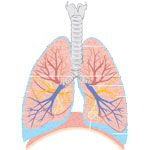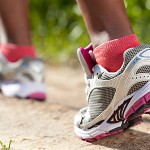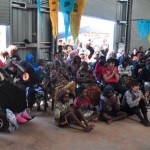
How Do Lungs Work?
Although from the outside your lungs may look like two giant bags, on the inside they are actually a lot more complicated – kind of like a giant sponge.
In . . .
When you breathe in, air flows down your trachea (windpipe) and into two large tubes called bronchi. One of these tubes goes into the left lung, the other goes into the right. These main bronchi then branch off into smaller and smaller tubes, the smallest of which are called bronchioles. Each bronchiole is about the same thickness as a human hair. Your have about 30,000 of these tiny tubes in each lung.
Even smaller still are the tiny air sacs that are clumped at the end of each bronchiole. These tiny sacs are called alveoli, and you have about 600 million of them. Each of these tiny sacs is covered in tiny veins, and it’s here that the oxygen from the lungs enters the bloodstream and heads up to the heart, where it and gets pumped around your entire body.
. . . And Out
When you breathe out, this all goes in reverse – all the carbon dioxide and other waste your blood needs to get rid of transfers back through the alveoli, through the bronchioles, up the bronchi and trachea and out of your mouth.
Did You Know?
- You don’t just need your lungs to breathe – you also need them to talk, sing, shout, laugh and cry. Air flowing through your vocal chords makes them vibrate, which is how you makes sounds!
- When you’re running, your lungs work together with your brain to allow them to breathe more air in and out faster.
- Your lungs breathe about 10,000 litres of air every day!
- Your lungs are lined with tiny hairs called cilia, which sweep your lungs clean of unwanted particles.
Think About It
Although you can breathe without even thinking about it, you still need to think about keeping your lungs healthy. Damaged or sick lungs don’t work as well at getting oxygen into your bloodstream, which can cause problems in all parts of your body.
THE BEST WAY TO KEEP YOUR LUNGS HEALTHY IS TO SAY NO TO SMOKING.
Smoking damages your lungs in several different ways. Firstly, the smoke you inhale actually paralyses the tiny hairs in your lungs that are meant to sweep out waste particles.
Your alveoli also get damaged because the chemicals in cigarette smoke hurt the delicate alveoli walls. This makes it harder for you to breathe, and harder for your body to get the oxygen it needs.
Also, smoking damages the cells of your lungs, and can make them turn cancerous.
Did You Know?
- Aboriginal people are smoking way too much – about 50 per cent of the Indigenous population smokes, which is about double that of the rest of the population.
- Around 20 per cent of adult Aboriginal deaths are caused by smoking-related illness.
- Health experts believe that reducing the rates of Indigenous smoking can help to close the gap between Indigenous and non-Indigenous life-expectancy by up to 30 per cent.
Keep Your Lungs Safe at Work
Some workplaces can contain dangerous chemicals or other substances that can damage your lungs and make you very sick.
Make sure you always wear a mask if you work anywhere that has dangerous fumes, vapours or dust.
You should also wear a mask if you’re doing housework with any strong chemical cleaners.
Love Your Lungs!
Keep your lungs strong by ditching the durries and by exercising.
When you do vigorous exercise like running, swimming, riding a bike or skating, your body needs more oxygen, so your lungs have to work harder. The more you exercise, the stronger and more efficient your lungs become.
!Health News Alert!
Top End Pneumonia Crisis
Pneumonia is a serious infection in the lungs. New research from the Menzies School of Health Research in Darwin has revealed that the Aboriginal population in the Top End of Australia have the highest rates of pneumonia in the world.
Although pneumonia is the single biggest killer of children around the world, little has been known about the impact this illness has been having on Indigenous children.
It has now been revealed that Aboriginal children in the Northern Territory may well have the highest rates of the disease in the entire world.
There is also evidence to suggest that recurring bouts of pneumonia can cause chronic lung disease in later life.
To help keep your kids healthy, make sure they have a balanced diet, get plenty of rest and see their doctor regularly for check ups. You should always take your child to the doctor if he or she is sick, especially if they have a fever and are short of breath.





Comments are closed.